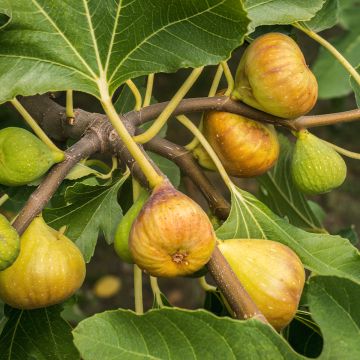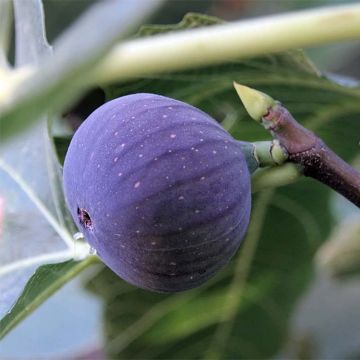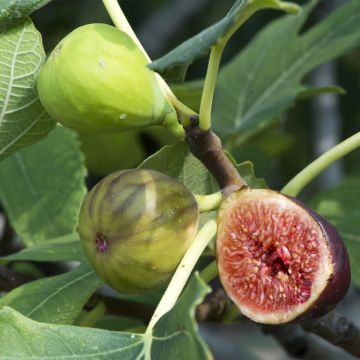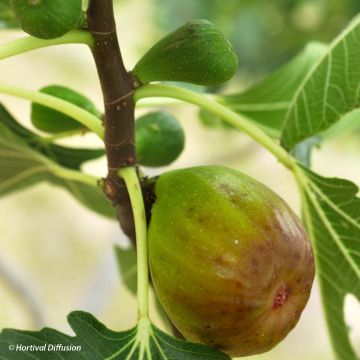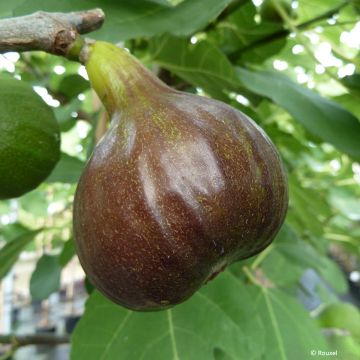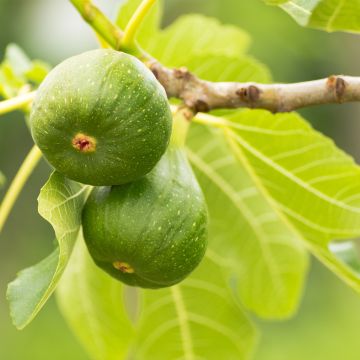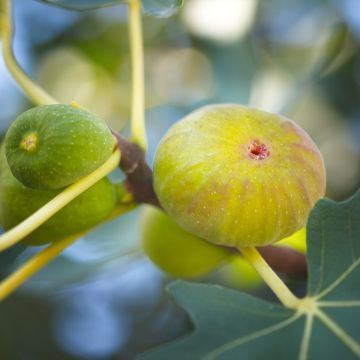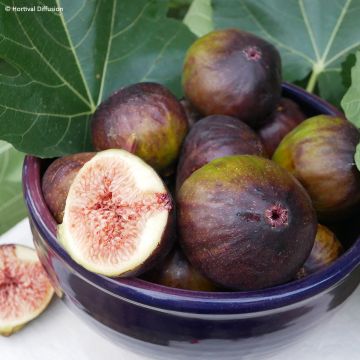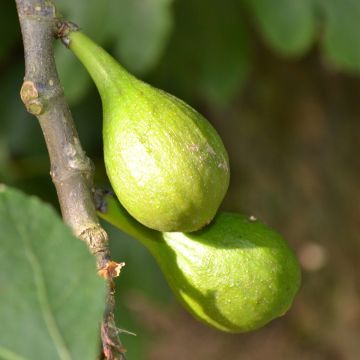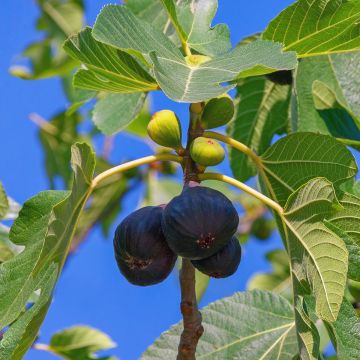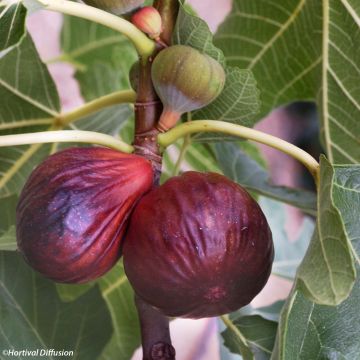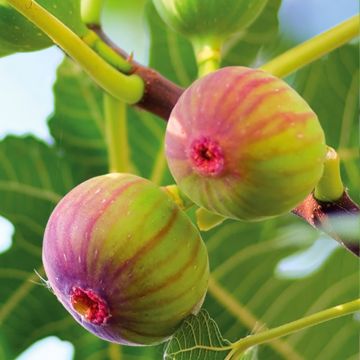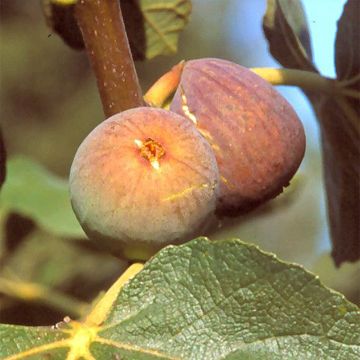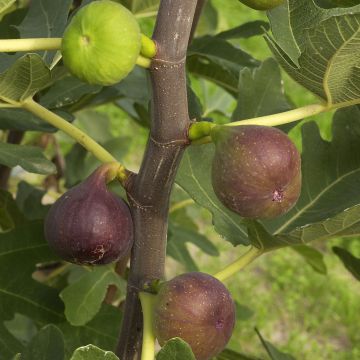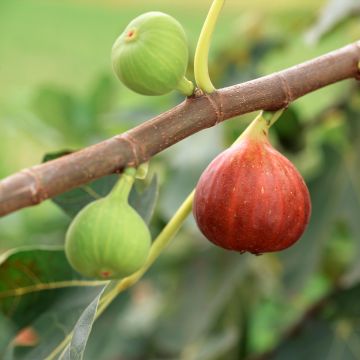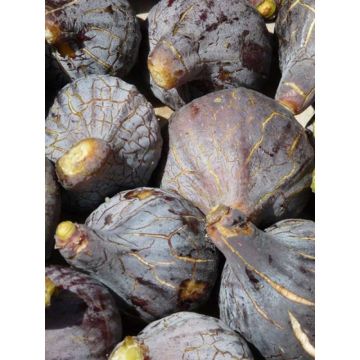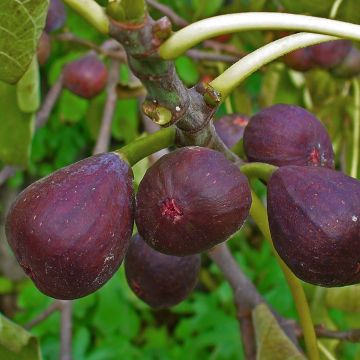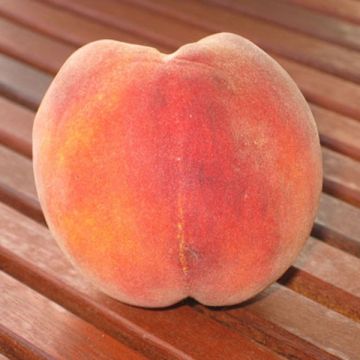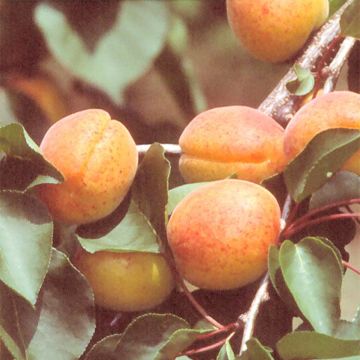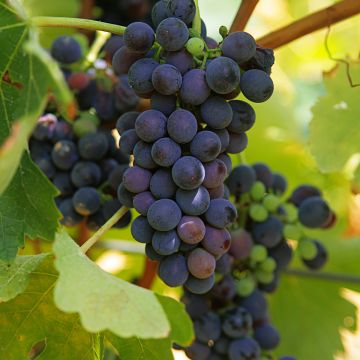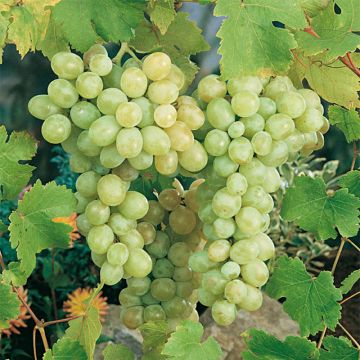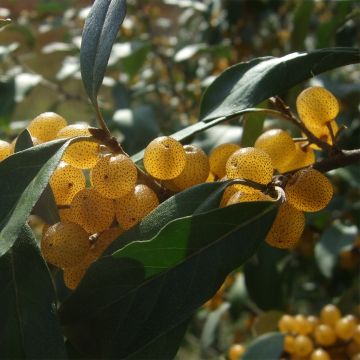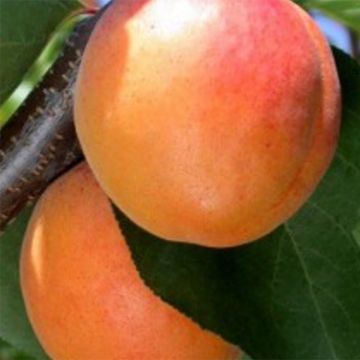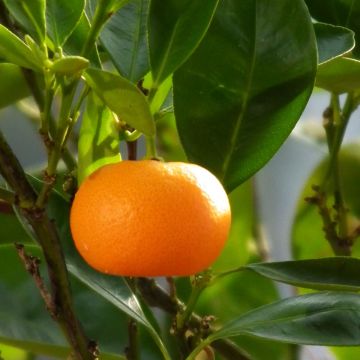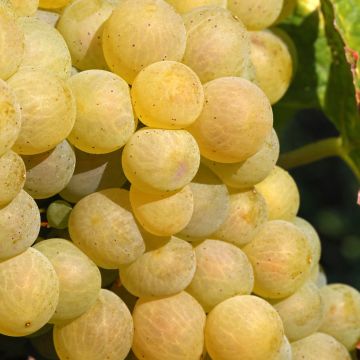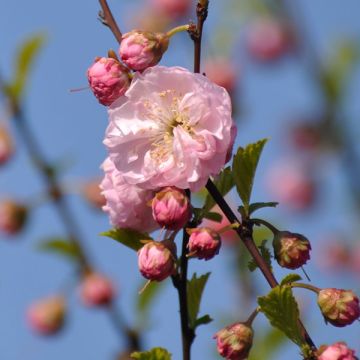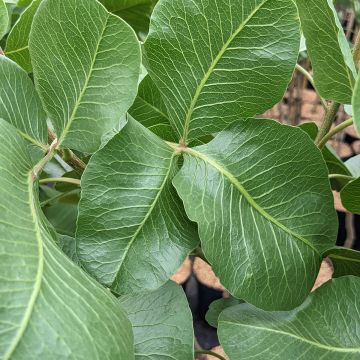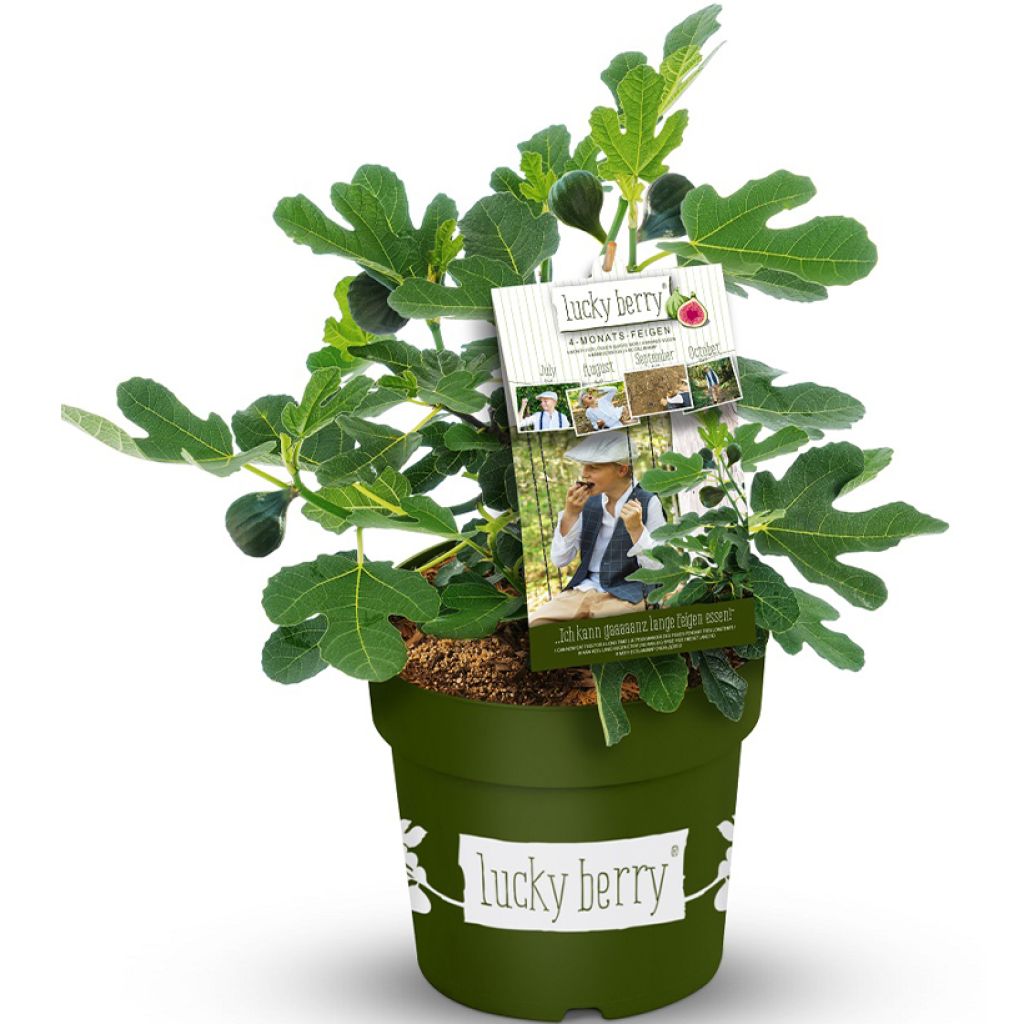

Fig Tree Lucky Berry
Fig Tree Lucky Berry
Ficus carica Lucky Berry®
Common Fig, Fig Tree
Why not try an alternative variety in stock?
View all →This plant carries a 6 months recovery warranty
More information
We guarantee the quality of our plants for a full growing cycle, and will replace at our expense any plant that fails to recover under normal climatic and planting conditions.
From €5.90 for pickup delivery and €6.90 for home delivery
Express home delivery from €8.90.
Description
The Fig Tree ‘Lucky Berry’ is a recent variety, with a dwarf and compact habit, capable of producing delicious fruits rich in vitamins and minerals consistently for 4 months, from July to October. The small to medium-sized, pear-shaped figs with thin skin, turning reddish-purple when ripe, have a red, juicy, fairly firm and very sweet pulp containing numerous small seeds (achenes). They can be eaten fresh as soon as they are picked, or used in various recipes. If there are any fruits left at the end of the season, they can be frozen to enjoy their sweet taste in winter. Its architectural habit and small size are assets for this fig tree, which offers many possibilities for integration in the garden, whether planted in the ground or grown in a pot. Plant in autumn-winter, frost-free (or in spring for colder regions). It is not very susceptible to diseases and requires almost no maintenance.
Originally from regions with a warm temperate climate, ranging from the Mediterranean to Central Asia, the Fig Tree (Ficus carica) belongs to the Moraceae family. Generally, it does not exceed three to four metres in height and has a fairly twisted trunk and a bushy habit. The deciduous leaves are rough and hairy, reaching up to 25 cm in length, divided into three to seven crenate lobes of variable shape. The underside of the leaf is velvety and shows prominent veins. The stems, leaves, and fruits contain a white latex that can be irritating. The wood, with its grey and smooth bark, is soft, spongy, and hollow. The running roots of the fig tree are powerful.
Ficus carica ‘Lucky Berry’ is part of a very innovative selection of fruit plants, marketed under the Lucky Berry brand. It complements a range that includes a blueberry, a strawberry, a raspberry, and a blackberry. All have been selected for their long harvest periods with high yields of sweet and juicy fruits, on compact vegetation suitable for container cultivation, while also being resistant to winter and diseases. This fig tree variety forms a small bush, with a rounded and branched habit, reaching a height of 1 to 1.50 m and a spread of 1 to 1.30 m at maturity (7 to 10 years old).
Among all the fig tree varieties, the Fig Tree ‘Lucky Berry’ stands out for its abundant and regular production from July to October. This staggered fruiting ensures a harvest of delicious figs throughout the season. The harvest will be done in several stages, as the fruits ripen. It is a self-fertile and parthenocarpic variety, producing fruits without fertilisation. It does not require other fig tree plants and does not rely on the only pollinating insect of the fig tree, which is too sensitive to survive in cold climates.
Ripe and sun-drenched figs can be eaten fresh as they are, revealing their full flavour and smoothness. They can also enhance sweet dishes such as tarts, clafoutis, and compotes, as well as savoury dishes with goat cheese, cured ham, or foie gras, but also as an accompaniment to poultry or white meats. The delicate and pronounced flavour of figs can be enhanced with honey. They also pair well with sweet fruits such as cherries, strawberries, raspberries, blackberries, currants, blueberries, and grapes. Among fruits for making jam, figs have a prominent place with their delicate and rich taste and very sweet flavour. Figs are rich in fibre, have laxative properties and their seeds aid digestion. They are also rich in minerals (calcium, potassium), trace elements, and vitamin B. After harvest, it is not recommended to store them in the refrigerator to preserve their flavour as the skin can suffer from moisture and condensation.
The easy-to-grow, Lucky Berry Fig Tree thrives in ordinary soil, with a preference for fertile, well-drained, and moist soils, even those with limestone. Once established, it quickly becomes a magnificent ornamental plant for your garden. This low-growing variety can easily be grown in a pot, making it perfect for balconies and terraces, in a patio or urban garden. Plant the Lucky Berry Fig Tree against a wall to protect it from cold during harsh winters, with a south or southwest exposure, either as a standalone plant, integrated into a flower bed, within a rock garden, or simply alongside other Fruit trees for small gardens, to create a fruitful hedge. With its small size, it can be grown in the coldest regions in a container that can be brought indoors when the temperature drops below -10°C.
Report an error about the product description
Plant habit
Fruit
Flowering
Foliage
Botanical data
Ficus
carica
Lucky Berry®
Moraceae
Common Fig, Fig Tree
Cultivar or hybrid
Other Fig trees
Planting and care
The Fig tree adapts to all types of soil, even poor, stony, and dry, or even rocky, but prefers deep, loose soil with a sufficiently high limestone content. It requires a sunny exposure, sheltered from strong winds (south or southwest). In summary, the fig tree likes to have its feet in the water and its head in the sun, especially during fruit ripening in summer. At the time of planting, install a layer of gravel at the bottom of the planting hole and add a mixture of garden soil and well-rotted compost or soil.
The first two years following planting, you will need to ensure that it does not lack water, especially in the summer, as its root system, although capable of drawing water deeply from the soil, is not sufficiently developed. It is not well adapted to mountain climates, where its success is a challenge. Plant from November to the end of March, outside of freezing periods. In colder regions, it is preferable to plant early in the spring.
For pot planting: install a layer of gravel or clay pellets at the bottom of the pot to facilitate drainage. Add a layer of soil and then place the plant and fill in with a mixture of 2/3 garden soil, 1/3 well-rotted compost or soil. Every spring, top-dress by replacing the surface layer with fresh compost. Water regularly and moderately. At the end of autumn, protect the pot with insulation before winter frosts.
The Fig tree is not very susceptible to diseases and pests.
Planting period
Intended location
Care
-
, onOrder confirmed
Reply from on Promesse de fleurs
Mediterranean fruit trees
Haven't found what you were looking for?
Hardiness is the lowest winter temperature a plant can endure without suffering serious damage or even dying. However, hardiness is affected by location (a sheltered area, such as a patio), protection (winter cover) and soil type (hardiness is improved by well-drained soil).

Photo Sharing Terms & Conditions
In order to encourage gardeners to interact and share their experiences, Promesse de fleurs offers various media enabling content to be uploaded onto its Site - in particular via the ‘Photo sharing’ module.
The User agrees to refrain from:
- Posting any content that is illegal, prejudicial, insulting, racist, inciteful to hatred, revisionist, contrary to public decency, that infringes on privacy or on the privacy rights of third parties, in particular the publicity rights of persons and goods, intellectual property rights, or the right to privacy.
- Submitting content on behalf of a third party;
- Impersonate the identity of a third party and/or publish any personal information about a third party;
In general, the User undertakes to refrain from any unethical behaviour.
All Content (in particular text, comments, files, images, photos, videos, creative works, etc.), which may be subject to property or intellectual property rights, image or other private rights, shall remain the property of the User, subject to the limited rights granted by the terms of the licence granted by Promesse de fleurs as stated below. Users are at liberty to publish or not to publish such Content on the Site, notably via the ‘Photo Sharing’ facility, and accept that this Content shall be made public and freely accessible, notably on the Internet.
Users further acknowledge, undertake to have ,and guarantee that they hold all necessary rights and permissions to publish such material on the Site, in particular with regard to the legislation in force pertaining to any privacy, property, intellectual property, image, or contractual rights, or rights of any other nature. By publishing such Content on the Site, Users acknowledge accepting full liability as publishers of the Content within the meaning of the law, and grant Promesse de fleurs, free of charge, an inclusive, worldwide licence for the said Content for the entire duration of its publication, including all reproduction, representation, up/downloading, displaying, performing, transmission, and storage rights.
Users also grant permission for their name to be linked to the Content and accept that this link may not always be made available.
By engaging in posting material, Users consent to their Content becoming automatically accessible on the Internet, in particular on other sites and/or blogs and/or web pages of the Promesse de fleurs site, including in particular social pages and the Promesse de fleurs catalogue.
Users may secure the removal of entrusted content free of charge by issuing a simple request via our contact form.
The flowering period indicated on our website applies to countries and regions located in USDA zone 8 (France, the United Kingdom, Ireland, the Netherlands, etc.)
It will vary according to where you live:
- In zones 9 to 10 (Italy, Spain, Greece, etc.), flowering will occur about 2 to 4 weeks earlier.
- In zones 6 to 7 (Germany, Poland, Slovenia, and lower mountainous regions), flowering will be delayed by 2 to 3 weeks.
- In zone 5 (Central Europe, Scandinavia), blooming will be delayed by 3 to 5 weeks.
In temperate climates, pruning of spring-flowering shrubs (forsythia, spireas, etc.) should be done just after flowering.
Pruning of summer-flowering shrubs (Indian Lilac, Perovskia, etc.) can be done in winter or spring.
In cold regions as well as with frost-sensitive plants, avoid pruning too early when severe frosts may still occur.
The planting period indicated on our website applies to countries and regions located in USDA zone 8 (France, United Kingdom, Ireland, Netherlands).
It will vary according to where you live:
- In Mediterranean zones (Marseille, Madrid, Milan, etc.), autumn and winter are the best planting periods.
- In continental zones (Strasbourg, Munich, Vienna, etc.), delay planting by 2 to 3 weeks in spring and bring it forward by 2 to 4 weeks in autumn.
- In mountainous regions (the Alps, Pyrenees, Carpathians, etc.), it is best to plant in late spring (May-June) or late summer (August-September).
The harvesting period indicated on our website applies to countries and regions in USDA zone 8 (France, England, Ireland, the Netherlands).
In colder areas (Scandinavia, Poland, Austria...) fruit and vegetable harvests are likely to be delayed by 3-4 weeks.
In warmer areas (Italy, Spain, Greece, etc.), harvesting will probably take place earlier, depending on weather conditions.
The sowing periods indicated on our website apply to countries and regions within USDA Zone 8 (France, UK, Ireland, Netherlands).
In colder areas (Scandinavia, Poland, Austria...), delay any outdoor sowing by 3-4 weeks, or sow under glass.
In warmer climes (Italy, Spain, Greece, etc.), bring outdoor sowing forward by a few weeks.

































